Fossils, Minerals & Gems
Fossils
Please be aware it is illegal to alter, damage, or destroy an archeological site on any lands, per Oregon Revised Statute 358.920
Finding fossils in Oregon is not so much a question of where to look for them as where not to look. Fossils are rare in the High Lava Plains and High Cascades, but even there, some of the lakes are famous for their fossils. Many of the sedimentary rocks in eastern Oregon contain fossil leaves or bones. Leaf fossils are especially abundant in the rocks at the far side of the athletic field at Wheeler High School in the town of Fossil. Although it is rare to find a complete animal fossil, a search of riverbeds may turn up chips or even teeth. In western Oregon, the sedimentary rocks that are primarily marine in origin often contain fossil clams and snails. An occasional shark’s tooth or crab can also be found. Marine fossils are also abundant near the town of Vernonia and along the central to south-central Oregon coast.
Fossil collecting is permitted on private land with the owner's approval. Collecting fossils is prohibited or a collecting permit is necessary to collect fossils on state and federal lands and in parks. Collecting is prohibited in the John Day Fossil Beds National Monument.
Learn more about paleontology and collecting on U.S. Forest Service lands
Metasequoia (Oregon State Fossil)
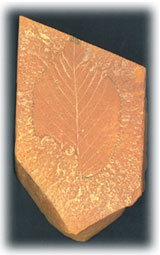
from the
Oregon Blue Book -- The legislature designated the Metasequoia, or dawn redwood, as the official state fossil for Oregon by resolution in 2005. The Metasequoia flourished in the Miocene epoch of 25 to 5 million years ago and left its record embedded in rocks across the Oregon landscape. While long extinct in Oregon, paleontologists discovered living 100-foot Metasequoia trees in a remote area of China over 50 years ago and brought specimens back to the United States for propagation, thus ensuring that live Metasequoia trees can be found today.
Minerals
Oregonite and josephinite (awaruite) are Oregon's official twin minerals, per Oregon Senate Concurrent Resolution 14.
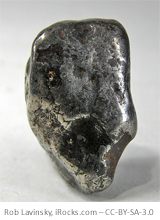
The mineralogy and origin of josephinite by Russell A. Morley, The Ore.-Bin, 1949, vol. 11, no. 10, p. 68-69,
Article is contained in full issue PDF.
A description of some of Oregon rocks and minerals,by Hollis M. Dole (1950), Lawrence L. Brown (2nd rev.), 1988 (2nd rev.), 59 p.
"The Discoveries of New Minerals Found in Oregon" (The Ore Bin, v. 24, no. 6, June 1962)
Note that DOGAMI does not provide assay or mineral identification services.
Gems
The Gem Minerals of Oregon (PDF of DOGAMI Bulletin 7, H.C. Dake, 1938)
Sunstone (Oregon State Gemstone)
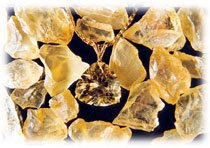
Oregon’s state gemstone is a feldspar crystal that weathers out of certain lava flows in south-central Oregon. Sunstone color relates to the amount of copper in the stone – 20 parts per million for yellow, 200 parts per million for red.
It may be collected on BLM land near Lakeview. Collecting on mining claims is prohibited. For information, contact BLM, 1000 South Ninth, PO Box 151, Lakeview, OR 97630, phone 541-947-2177.
Learn more about Oregon Sunstone from Oregon Geology, v. 49, no. 2, p. 23.
Agates & Jasper
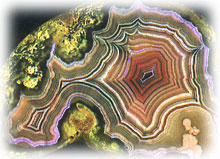
Agate and jasper are part of thechalcedony family, a variety of quartz. Distinctly banded specimens that differ in color and in degree of translucency are called agate; and mottled yellow, red, brown or green chalcedony is called jasper. These semiprecious gemstones can be collected at many sites along the Oregon coast, including Agate Beach at Newport, in some of the streams draining the Western Cascade, near the town of Antelope and around Prineville in central Oregon, near Hart Mountain and Lakeview in south-central Oregon, and at Succor Creek in southeastern Oregon.
Thunderegg (Oregon State Rock)
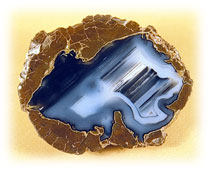
The thunderegg (geode) was named state rock by the 1965 Legislature after rockhounds throughout Oregon voted it first choice. The thunderegg is a structurecreated in welded tuff or perlitic rocks. Thunder-eggs range in diameter from less than one inch to over four feet. Nondescript on the outside, they reveal exquisite designs in a wide range of colors when cut and polished. They are found chiefly in Crook, Jefferson, Malheur, Wasco and Wheeler counties.
Oregon’s state rock can be collected at fee and free sites in central and southeastern Oregon. Unimpressive on the outside, these spherical rocks contain colorful silicic material and, when sliced and polished, make beautiful collector’s items.
Thunderegg Sites
For information on
places to collect in central Oregon, contact:
- Madras Chamber of Commerce, 197 SE 5th St., Madras OR 97741, phone 541-475-2350;
- Prineville Chamber of Commerce, 390 North Fairview, Prineville, OR 97754, phone 541-447-6304.
In Southeastern Oregon, contact the Bureau of Land Management (BLM), 100 Oregon Street, Vale OR 97918, phone 541-473-3144,
To find out more about Thunderegg Days (held for five days around the first of June), in Nyssa, contact the Nyssa Chamber of Commerce at 541-372-3091.
Obsidian
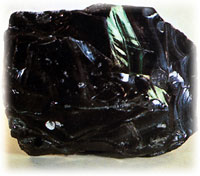
Obsidian is volcanic glass and can be flakedto an edge much sharperthan any knife or razor edge. Obsidian can be collected in central Oregon at Glass Butte (arockhounding siteon BLM land) on Highway 20 between Bend and Burns. An enormous flow of obsidian can also be seen at Newberry Crater, south and east of Bend, but no collecting is permitted in this national monument. The edge of obsidian